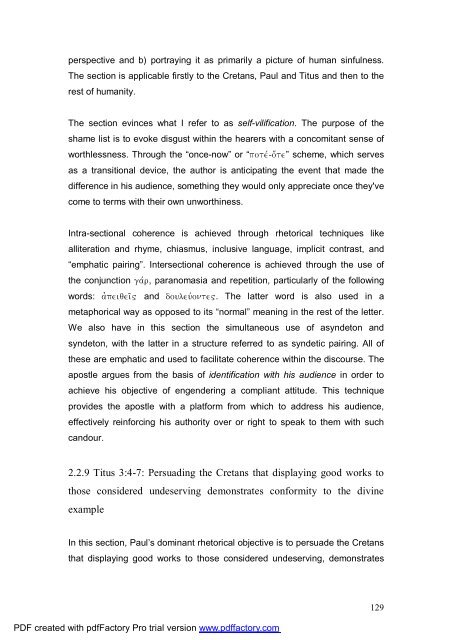A Text centred rhetorical analysis of Paul's Letter to Titus
A Text centred rhetorical analysis of Paul's Letter to Titus
A Text centred rhetorical analysis of Paul's Letter to Titus
Create successful ePaper yourself
Turn your PDF publications into a flip-book with our unique Google optimized e-Paper software.
perspective and b) portraying it as primarily a picture <strong>of</strong> human sinfulness.<br />
The section is applicable firstly <strong>to</strong> the Cretans, Paul and <strong>Titus</strong> and then <strong>to</strong> the<br />
rest <strong>of</strong> humanity.<br />
The section evinces what I refer <strong>to</strong> as self-vilification. The purpose <strong>of</strong> the<br />
shame list is <strong>to</strong> evoke disgust within the hearers with a concomitant sense <strong>of</strong><br />
worthlessness. Through the “once-now” or “potev-o{te” scheme, which serves<br />
as a transitional device, the author is anticipating the event that made the<br />
difference in his audience, something they would only appreciate once they've<br />
come <strong>to</strong> terms with their own unworthiness.<br />
Intra-sectional coherence is achieved through <strong>rhe<strong>to</strong>rical</strong> techniques like<br />
alliteration and rhyme, chiasmus, inclusive language, implicit contrast, and<br />
“emphatic pairing”. Intersectional coherence is achieved through the use <strong>of</strong><br />
the conjunction gavr, paranomasia and repetition, particularly <strong>of</strong> the following<br />
words: ajpeiqei`" and douleuvonte". The latter word is also used in a<br />
metaphorical way as opposed <strong>to</strong> its “normal” meaning in the rest <strong>of</strong> the letter.<br />
We also have in this section the simultaneous use <strong>of</strong> asynde<strong>to</strong>n and<br />
synde<strong>to</strong>n, with the latter in a structure referred <strong>to</strong> as syndetic pairing. All <strong>of</strong><br />
these are emphatic and used <strong>to</strong> facilitate coherence within the discourse. The<br />
apostle argues from the basis <strong>of</strong> identification with his audience in order <strong>to</strong><br />
achieve his objective <strong>of</strong> engendering a compliant attitude. This technique<br />
provides the apostle with a platform from which <strong>to</strong> address his audience,<br />
effectively reinforcing his authority over or right <strong>to</strong> speak <strong>to</strong> them with such<br />
candour.<br />
2.2.9 <strong>Titus</strong> 3:4-7: Persuading the Cretans that displaying good works <strong>to</strong><br />
those considered undeserving demonstrates conformity <strong>to</strong> the divine<br />
example<br />
In this section, Paul’s dominant <strong>rhe<strong>to</strong>rical</strong> objective is <strong>to</strong> persuade the Cretans<br />
that displaying good works <strong>to</strong> those considered undeserving, demonstrates<br />
PDF created with pdfFac<strong>to</strong>ry Pro trial version www.pdffac<strong>to</strong>ry.com<br />
129

















